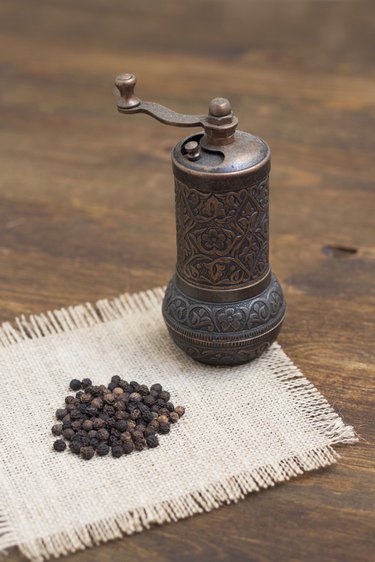Things You'll Need
Pepper mill
Salt mill
Peppercorns
Coarse or rock salt
Paper coffee filter (optional)
Small salt scoop (optional)
Wide-mouth funnel (optional)

Pepper and salt mills can be working utensils or culinary sculptures that look as good on the table as in the kitchen. A pepper mill grinds fresh peppercorns to a desired flake size -- from very fine powder to cruder individual flakes. It can usually be adjusted with a screw mechanism on the lid. Most mills work by storing the peppercorns in the top, letting gravity funnel them downward where the blades of the mills grind them. Salt mills work in a similar way, but salt should be used in its own mill. It is too corrosive for the blades of a pepper mill.
Step 1
Fill the pepper mill by sliding the cover of the filler aperture open or popping it up, depending on how the mill is designed. If the pepper mill requires removing the top to pour peppercorns into it, remove the screw and the top and fill the chamber no more than three-fourths full. When the chamber is filled to the top, the peppercorns can't move when the grinder displaces them and the whole apparatus goes into gridlock.
Video of the Day
Step 2
Avoid problems with a too-small opening with the coffee filter trick. If the grinder has a narrow aperture that makes it difficult to fill without spilled peppercorns rolling all over the floor, first pour the peppercorns into a paper coffee filter. Pinch the filter to create a narrow channel that directs the peppercorns right inside the opening and into the mill. Tuck the paper filter in the supply jar for peppercorns so it will be handy the next time the pepper mill needs filling.
Step 3
Do a quick test run to be sure no peppercorns have jammed the blades and that the mill is not overfilled and that you have fastened the aperture or reconnected the twist top securely. Twist the top, turn the crank or depress the button that activates the mill. It's safer to check out your refill in the kitchen before a major glitch over the Caesar salad at the table. Ceramic blades give you the most control over grind size. Steel provides a coarse grind easily.
Step 4
Fill a salt mill with the appropriate type of salt. Not all salt belongs in a mill. Use only dry salt crystals specifically meant to be ground. Kosher salt, crystal sea salt, and pretzel salt are all large, dry salt flakes and crystals that can be ground to the desired consistency in a salt mill. There are very few salt mills designed to handle damp or wet sea salts. For lovers of moist French "sel gris," it may be worth seeking them out. Damp-salt mills are usually top-fill, are made from corrosion-resistant materials and use a central turning mechanism to move the salt as it is ground, preventing hardening or clumping.
Step 5
Use only salt mills constructed with stainless steel or ceramic grinders. Salt corrodes metal and it will ruin any other types of metal grinder blades. You also risk tiny flecks of metal added to the ground salt when the mechanism is degraded. A small, wide-mouth plastic funnel can be used to fill the salt mill neatly when you are using dry crystals. Damp sea salt might best be transferred to the salt mill with a small scoop or spoon. You can leave salt in a salt mill for a long time, even if you aren't using it. Salt is a mineral and will not lose its flavor or go bad.
Video of the Day